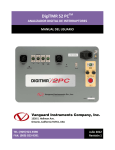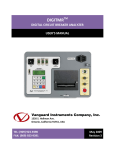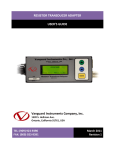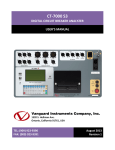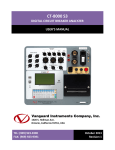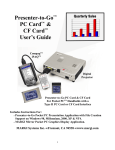Download DigiTMR S2 PC User`s Manual - Vanguard Instruments Company, Inc.
Transcript
DigiTMR S2 PCTM DIGITAL CIRCUIT BREAKER ANALYZER USER’S MANUAL Vanguard Instruments Company, Inc. 1520 S. Hellman Ave. Ontario, California 91761, USA TEL: (909) 923-9390 FAX: (909) 923-9391 July 2012 Revision 1 DIGITMR S2 PC USER’S MANUAL REV 1 SAFETY SUMMARY FOLLOW EXACT OPERATING PROCEDURES Any deviation from the procedures described in this User’s Manual may create one or more safety hazards, may damage the DigiTMR S2 PC, or cause errors in the test results. Vanguard Instruments Company, Inc. assumes no liability for unsafe or improper use of the DigiTMR S2 PC. All safety precautions provided in this manual must be observed during all phases of testing including test preparation, test lead connection, actual testing, and test lead disconnection. SAFETY WARNING AND CAUTIONS The DigiTMR S2 PC shall be used only by trained operators. When using the DigiTMR S2 PC in Time-versus-Travel mode, all circuit breakers under test shall be off-line and fully isolated. DO NOT MODIFY TEST EQUIPMENT To avoid the risk of introducing additional or unknown hazards, do not install substitute parts or perform any unauthorized modification to any DigiTMR S2 PC test unit. To ensure that all designed safety features are maintained, it is highly recommended that repairs be performed only by Vanguard Instruments Company factory personnel or by an authorized repair service provider. Unauthorized modifications can cause safety hazards and will void the manufacturer’s warranty. WARNING Do not remove test leads during a test. Failure to heed this warning can result in damage to the equipment. i REV 1 DIGITMR S2 PC USER’S MANUAL TABLE OF CONTENTS 1.0 INTRODUCTION .................................................................................................................... 1 1.1 General Description and Features ................................................................................... 1 1.2 Operational Modes .......................................................................................................... 3 1.2.1. “On-Line” Mode ....................................................................................................... 3 1.2.2. Time-versus-Travel Circuit Breaker Analyzer Mode ................................................. 3 1.3 Technical Specifications ................................................................................................... 4 1.4 DigiTMR S2 PC Controls and Indicators ........................................................................... 5 2.0 OPERATING PROCEDURES ................................................................................................... 6 2.1 Configuring the VCBA S2 Software for use with the DigiTMR S2 PC ............................... 6 2.2 Connecting the DigiTMR S2 PC to a PC via Bluetooth ..................................................... 8 2.3 DigiTMR S2 PC Cable Connections ................................................................................. 16 2.3.1. Contact Cable Connections .................................................................................... 16 2.3.2. Initiate Cable Connections ..................................................................................... 17 2.3.3. Analog and Digital Voltage Monitor Connections .................................................. 19 2.3.5. AC Current Sensor Connection ............................................................................... 22 2.3.6. Transducer Connections ......................................................................................... 23 3.0 GLOSSARY OF TERMS ......................................................................................................... 26 4.0 Compatible Transducers and Transducer Adapters .......................................................... 27 LIST OF TABLES Table 1. DigiTMR S2 PC Technical Specifications ............................................................................ 4 LIST OF FIGURES Figure 1. DigiTMR S2 PC Controls and Indicators ........................................................................... 5 Figure 2. Contact Cable Connections ............................................................................................ 16 Figure 3. DC Trip and DC Close Initiate Circuit Cable Connections ............................................... 17 Figure 4. DC Trip and AC Close Initiate Circuit Cable Connections ............................................... 18 Figure 5. Analog and Digital Voltage Monitoring Cable Connections .......................................... 19 Figure 6. External Trigger Cable Connection for an Open Connection......................................... 20 Figure 7. External Trigger on a Close Operation Less 52Y Delay Time ......................................... 21 Figure 8. Typical CT Connection .................................................................................................... 22 Figure 9. Typical Transducer Connection ...................................................................................... 23 Figure 10. Typical Resistor Type Transducer Connection ............................................................. 24 Figure 11. Vanguard Resistor Transducer Adapter Connected to an ABB AHMB Transducer ..... 24 Figure 12. Vanguard Doble Transducer Adapter Connected to a Doble Linear Transducer ........ 25 Figure 13. Vanguard Doble Transducer Adapter Connected to a Doble Rotary Transducer ....... 25 ii DIGITMR S2 PC USER’S MANUAL 1.0 INTRODUCTION 1.1 General Description and Features REV 1 The Vanguard DIGITMR S2 PC is an inexpensive, easy to use digital circuit breaker analyzer that is designed to be used with a PC. This inexpensive analyzer offers the most cost-effective method for testing circuit breakers. It can fully analyze a circuit-breaker’s performance by testing the contact time, stroke, velocity, over-travel, and contact wipe. Contact-motion analysis can be performed for all breaker contact operations (Open, Close, Open – Close, Close – Open, and Open – Close – Open). The DIGITMR S2 PC offers three dry-contact channels (for timing circuit breaker main and insertion resistor contacts), one digital transducer channel (to monitor CB contact motion), and two voltage monitoring channels. “On-Line” Timing Mode Option An optional “on-line” timing mode is available for the DIGITMR S2 PC. In this mode, the DIGITMR S2 PC captures the breaker’s trip or close time, the trip/close coil current “fingerprint,” and the battery supply voltage while the breaker is still in service. The trip/close time is derived from the time of trip, or close coil initiation, to the breaker’s bushing current breaker-make as detected by an AC clamp-on current sensing probe. The “on-line” timing mode can detect a breaker’s operating conditions with little or no down time. In this mode, the first trip operation time of the breaker is captured. If a breaker has been in service for a long period of time and sitting in close position, the first trip time of the breaker may be slow possibly due to a sticky mechanism. The “on-line” mode is very useful in such cases because traditional breaker timing may not detect this condition since several operations may have occurred before the first timing test is conducted. Open/Close Coil Current Monitoring A built-in Hall-Effect current sensor records the circuit breaker’s operating coil current amplitude and duration. The circuit breaker’s operating-coil waveforms (effectively, a performance “fingerprint” or “current profile”) can be used as a diagnostic tool for analyzing a circuit breaker’s performance. Contact Timing Inputs Dry-contact input channels are used for timing circuit-breaker contacts. Each contact input channel can detect main contact and insertion resistor contact times in milliseconds and cycles. Three contact timing channels are available on the DIGITMR S2 PC. Breaker Stroke and Velocity One digital transducer input channel is available to measure circuit breaker contact stroke, velocity, over-travel, and bounce-back. With the use of a Vanguard digital travel transducer, no set-up calibration is required before testing. A special feature is also available to “Slow-Close” test a circuit breaker and obtain test results. An optional Resistor Transducer Adapter Device can be used to interface with any resistor transducer. 1 REV 1 DIGITMR S2 PC USER’S MANUAL CT Input One non-contact AC current sensor is used to monitor circuit breaker on-line current for the “on-line” timing mode. Voltage Monitoring Input One analog input channel, designated as (V1), is dedicated to monitoring the substation DC supply or coil voltage (0-255 Volts, DC or peak AC). A second voltage input channel, designated as V2, is dedicated to detecting voltage On/Off status (presence or absence). This input can be used to monitor the status of an A/B switch. Circuit Breaker Initiate Feature A built-in solid-state initiate device is used to operate the circuit breaker from the DIGITMR S2 PC. Operational modes include Open, Close, Open-Close, Close-Open, and Open-Close-Open. Multiple operations such as Open-Close, Close-Open, and Open-Close-Open can be initiated using a programmable delay or by sensing the circuit breaker’s contact condition. Computer Interface One USB interface port and an optional Bluetooth interface is available for computer-control. Vanguard's Windows®-based Circuit Breaker Analyzer Series 2 (VCBA S2) software is included with each DIGITMR S2 PC. The software can be used to control the unit, review test records, and create circuit breaker test plans. Test records can be exported to PDF, Excel, and XML format. All future software updates can be downloaded from the Vanguard web site at no additional charge. 2 DIGITMR S2 PC USER’S MANUAL 1.2 REV 1 Operational Modes 1.2.1. “On-Line” Mode In “On-Line” mode, the trip/close time is derived from the time of trip, or close-coil initiation, to the breaker’s bushing current-break-or-make as detected by an AC clamp-on current sensing probe. The DigiTMR S2 PC can time a circuit breaker’s OPEN operation by sensing the time when the OPEN coil is energized until the bushing CT current returns to zero. The breaker’s CLOSE time is detected when the close coil is energized until the bushing CT current is detected. The “On-Line” mode provides a quick way to diagnose a breaker’s performance and can reduce maintenance costs. 1.2.2. Time-versus-Travel Circuit Breaker Analyzer Mode In Time-versus-Travel mode, the DigiTMR S2 PC applies a test voltage of 35 Vdc to each of the contact channels, thus allowing an analog to digital converter (A/D) to determine a close, open, or an insertion resistor as the state of the contact. The DigiTMR S2 PC records into memory 20,000 readings (in on second) from the A/D’s and the transducer position counters. The contact time, circuit breaker stroke and velocity are then derived from the stored data. NOTE The DigiTMR S2 PC’s travel transducer employs optical encoders to send quadrature signals to the unit’s counters. With the use of digital transducers and counters, the need to setup or calibrate the transducers is eliminated. 3 REV 1 1.3 DIGITMR S2 PC USER’S MANUAL Technical Specifications Table 1. DigiTMR S2 PC Technical Specifications TYPE PHYSICAL SPECIFICATIONS INPUT POWER DRY-CONTACT INPUTS TIMING WINDOWS TIMING RESOLUTIONS TIMING ACCURACY DRY-CONTACT DETECTION RANGE RESISTOR DETECTION RANGE TRIGGER INPUT VOLTAGE Portable digital circuit breaker analyzer 18.5"W x 14"H x 7"D (47.0 cm x 35.7cm x 17.6 cm); Weight: 16 lbs (7.3 kg) 3 Amps, 100 – 240 Vac, 50/60 Hz 3 dry-contact channels; each channel detects main contact and insertion resistor contact 1 second, 10 seconds, or 20 seconds ±50 micro-seconds @ 1 sec. duration, ±500 micro-seconds @ 10 sec. duration, ±1.0 milliseconds @ 20 sec. duration 0.05% of reading ±0.1 milliseconds @ 1 second duration Closed: less than 20 ohms; Open: greater than 5,000 Ohms 50 – 5,000 ohms Open/Close: 30 – 300 V, DC or peak AC VOLTAGE SENSING INPUT RANGE V1: analog input; 0 – 255V, DC or peak AC; Sensitivity: ±1V V2: voltage presence/absence detector input; 30 – 300V, DC or peak AC BREAKER OPERATIONS Initiate Open, Close, Open – Close, Close – Open, Open – Close – Open BREAKER INITIATE CAPACITY INITIATE CURRENT READING RANGE DIGITAL TRAVEL TRANSDUCER INPUT CONTACT TRAVEL POINT DIFFERENCE CT CURRENT SENSOR COMPUTER INTERFACES PC SOFTWARE SAFETY ENVIRONMENT 30A, 250 Vac/dc max One, non-contact, Hall-effect sensor, 0 – 20 amp range, dc to 5Khz 1 digital travel transducer channel; linear range: 0.0 – 60.0 in (±0.005 in) rotary range: 0 – 360 degrees (±0.006 degrees) Measures “slow-close” contact-point distances; results can be printed One, non-contact, 0-100A One USB port, optional Bluetooth interface Windows®-based Circuit Breaker Analysis software (VCBA S2) included with purchase price. Software updates available at no additional charge Designed to meet UL/IEC 61010 and CAN/CSA C22.2 No. 1010.1-92 standards Operating: -10°C to 50° C (15°F to +122° F); Storage: -30° C to 70° C (-22°F to +158° F) HUMIDITY 90% RH @ 40°C (104°F) non-condensing ALTITUDE 2,000 m (6,562 ft) to full safety specifications CABLES OPTIONS WARRANTY Furnished with full set of test leads (including 20-foot contact leads and 30-foot contact lead extensions) transportation case (available for the DIGITMR S2 and travel transducers) One year on parts and labor The above specifications are valid at nominal operating voltage and at a temperature of 25°C (77°F). Specifications may change without prior notice. NOTE 4 DIGITMR S2 PC USER’S MANUAL 1.4 REV 1 DigiTMR S2 PC Controls and Indicators The DigiTMR S2 PC’s controls and indicators are shown in Figure 1 below. The purpose of the controls and indicators may seem obvious, but users should become familiar with them before using the DigiTMR S2 PC. Accidental misuse of the controls will usually cause no serious harm. Users should also be familiar with the safety summary found on the front page of this User’s Manual. Figure 1. DigiTMR S2 PC Controls and Indicators 5 REV 1 DIGITMR S2 PC USER’S MANUAL 2.0 OPERATING PROCEDURES 2.1 Configuring the VCBA S2 Software for use with the DigiTMR S2 PC The DigiTMR S2 PC is operated using the Vanguard Circuit Breaker Analyzer Series 2 (VCBA S2) PC software. Follow the steps below to properly connect the DigiTMR S2 PC and configure the VCBA S2 application to recognize the unit. a. Install the VCBA S2 software (please see the VCBA S2 software user’s manual for details) b. Connect the DigiTMR S2 PC to the PC by connecting a USB cable from an open USB port on the PC to the unit’s “USB PC” port. c. Turn on the power on the DigiTMR S2 PC. d. If this is the first time you are connecting the unit to the PC, Windows will recognize it as a new device and automatically install necessary drivers. If using Windows XP, you may be prompted to install drivers. Select the automatic installation option and Windows will locate the generic drivers necessary. e. Please note that although the unit is connected via USB, it uses an internal serial interface to communicate with the PC. As such, it will appear in the windows Device Manager as a USB Serial Port. Open the Device Manager from the Windows Control Panel and note the COM port number. For example, in the installation shown below, the DigiTMR S2 PC is shown as COM10 (USB Serial Port). 6 DIGITMR S2 PC USER’S MANUAL REV 1 f. Launch the VCBA S2 application. From the “Sys-Config” menu, select “System Setup…”. The following window will be displayed: Make sure that the “Enable USB” option is UN-checked. Then, from the “Port” dropdown menu, select the COM port that corresponds to the port that the DigiTMR S2 PC is connected to. Then click the OK button. The VCBA S2 software will now recognize the DigiTMR S2 PC. 7 REV 1 2.2 DIGITMR S2 PC USER’S MANUAL Connecting the DigiTMR S2 PC to a PC via Bluetooth The DigiTMR S2 PC can also be connected wirelessly to a PC using Bluetooth (if the Bluetooth option is installed). To connect the unit via Bluetooth, it must first be paired with the PC. Follow the steps below to pair the DigiTMR S2 PC to a PC via Bluetooth: For Windows XP: a. Make sure the DigiTMR S2 PC is turned on. Then double click on the Bluetooth system tray icon (on the bottom right corner of your computer screen): b. The “My Bluetooth Places” window will be displayed: Click on “Add a Bluetooth Device” on the left window pane. c. The Bluetooth Setup Wizard window will be displayed. Click on the “Next” button. The PC will scan for nearby devices and list all available Bluetooth devices: 8 DIGITMR S2 PC USER’S MANUAL REV 1 The DigiTMR S2 PC will be listed as “DigiTmr S/N” where S/N is the device’s serial number. Click on the icon for the DigiTMR S2 PC and then click on the “Next” button. d. The following window will be displayed asking for a secret key to connect to the DigiTMR S2 PC: Type the word “default” (without the quotes and in all lower-case) and then click on the “Next” button. e. The following window will be displayed with the option to connect to the DigiTMR S2 PC as a serial port: Make sure to check the box next to “AT Serial” and then click on the “Next” button. 9 REV 1 DIGITMR S2 PC USER’S MANUAL f. The following confirmation screen will be displayed: Click on the “Finish” button. g. The DigiTMR S2 PC will now be displayed in the “My Bluetooth Places” window: Note the port number listed under the device name. In the above case, the port number is COM14. Follow the directions in section Error! Reference source not found. to configure the VCBA S2 software to connect to the DigiTMR S2 PC using this COM port. 10 DIGITMR S2 PC USER’S MANUAL REV 1 For Windows 7: a. Make sure the DigiTMR S2 PC is turned on. Then double click on the Bluetooth system tray icon (on the bottom right corner of your computer screen): b. The “Bluetooth Devices” window will be displayed: Click on “Add a device”. 11 REV 1 DIGITMR S2 PC USER’S MANUAL c. All nearby Bluetooth devices will be listed: The DigiTMR S2 PC will be listed as “DigiTmr S/N” where S/N is the device’s serial number. Click on the icon for the DigiTMR S2 PC and then click on the “Next” button. d. The device pairing screen will be displayed: Click on “Enter the device’s pairing code” option. 12 DIGITMR S2 PC USER’S MANUAL REV 1 e. The following window will be displayed: Type the word “default” (without the quotes and in all lower-case) in the text box and click on the “Next” button. f. The following screen will be displayed: Click on the “Close” button. 13 REV 1 DIGITMR S2 PC USER’S MANUAL g. The DigiTMR S2 PC will now be listed under “Bluetooth Devices”: Right click on the DigiTmr S2 PC icon and select “Properties” from the pop-up menu. h. The properties window will be displayed. Click on the “Hardware” tab: 14 DIGITMR S2 PC USER’S MANUAL REV 1 Note the port number listed after the device name (COM23 in the above example). Follow the directions in section Error! Reference source not found. to configure the VCBA S2 software to connect to the DigiTMR S2 PC using this COM port. 15 REV 1 2.3 DIGITMR S2 PC USER’S MANUAL DigiTMR S2 PC Cable Connections 2.3.1. Contact Cable Connections A typical contact cable connection to a circuit breaker is shown in Figure 2. Red clips are connected to phase A, B, and C of the breaker’s bushings. The black clips are connected to the ground or common side of the bushings. If the common side of the bushing is not grounded, jumpers should be installed between the bushings. NOTE It is advisable to ground one side of the contacts for most testing purposes. If a breaker is floating or ungrounded, ensure that the contact input channels are protected against static discharge. Figure 2. Contact Cable Connections 16 DIGITMR S2 PC USER’S MANUAL REV 1 2.3.2. Initiate Cable Connections The DigiTMR S2 PC will trip or close breakers through a solid-state device which will operate on any AC or DC control voltage ranging from 10 to 300 Volts. Both the trip and close circuits are protected by 5-Ampere fuses. A typical DC trip and DC close control circuit test connection is shown in Figure 3. A typical DC trip and AC close control circuit is shown in Figure 4. NOTE Always connect the initiate circuit with an auxiliary switch in series. The auxiliary switch provides the coil current interruption. Failure to follow this recommendation will damage the DigiTMR S2 PC initiate circuit. Figure 3. DC Trip and DC Close Initiate Circuit Cable Connections 17 REV 1 DIGITMR S2 PC USER’S MANUAL Figure 4. DC Trip and AC Close Initiate Circuit Cable Connections 18 DIGITMR S2 PC USER’S MANUAL REV 1 2.3.3. Analog and Digital Voltage Monitor Connections The analog voltage input “V1” is dedicated to monitoring a breaker’s DC control voltage during an operation. The analog input records the nominal DC voltage at no load and the minimum DC voltage while the Trip or Close coil is energized. Nominal and minimum voltage readings can be printed on a tabulated report. Analog waveforms can also be plotted graphically. Using the reports, the user can see the breaker’s DC control voltage “dip” under load conditions and can easily detect problems such as a poor connection or an excessive voltage drop. The digital voltage input “V2” monitors the voltage status as “ON” or “OFF” states and can graph the results. A typical analog voltage monitoring connection (V1) and a typical digital monitoring connection (V2) are shown in Figure 5. Maximum voltage recorded is 255 Vdc. NOTE Figure 5. Analog and Digital Voltage Monitoring Cable Connections 19 REV 1 DIGITMR S2 PC USER’S MANUAL 2.3.4. External Trigger Input Connections The External Trigger Mode can be used to start recording when the DigiTMR S2 PC senses a voltage (see Figure 6). This feature can be used to time a circuit breaker without using the initiate circuit (for example, if the initiate circuit is non-operational). Another typical application for the External Trigger Mode is to time a circuit breaker in a close operation and to start timing only when the close coil is energized, thus bypassing the 52Y relay delay time. The DigiTMR S2 PC will energize the 52Y relay to start the close operation and will then start timing when it senses the voltage across the closing coil. Please see Figure 7 for a typical test connection. Another application for the External Trigger Mode is to start timing the breaker when the user trips or closes the breaker remotely. NOTES • Minimum trigger voltage is set at 30 Vac/dc. Maximum continuous voltage is set at 300 Vac/dc. • Different trigger voltages can be set at the factory based on specific user requests. • The DigiTMR S2 PC will start looking for the external trigger voltage when the message “AWAITING TRIGGER…” is shown on the LCD. If the external trigger voltage is not sensed by the DigiTMR S2 PC within ten seconds after the initiate sequence has begun, the DigiTMR S2 PC will return to the main menu. Figure 6. External Trigger Cable Connection for an Open Connection 20 DIGITMR S2 PC USER’S MANUAL REV 1 Figure 7. External Trigger on a Close Operation Less 52Y Delay Time 21 REV 1 DIGITMR S2 PC USER’S MANUAL 2.3.5. AC Current Sensor Connection The DigiTMR S2 PC can sense a breaker’s bushing current by using a clamp-on AC current sensor connected to the breaker’s bushing CT. The AC current sensor is used in “On-Line” Mode only. The AC current sensor requires a minimum of 100 mA to operate. The maximum current is 25 Amperes. A typical AC sensor connection is shown in Figure 8. Figure 8. Typical CT Connection 22 DIGITMR S2 PC USER’S MANUAL REV 1 2.3.6. Transducer Connections A typical transducer connection is shown in Figure 9. Figure 9. Typical Transducer Connection 23 REV 1 DIGITMR S2 PC USER’S MANUAL The DigiTMR S2 PC can also be connected to a resistor type transducer such as the ABB AHMB (see Figure 10 and Figure 11) using the Vanguard Resistor Transducer Adapter (sold separately). Figure 10. Typical Resistor Type Transducer Connection Figure 11. Vanguard Resistor Transducer Adapter Connected to an ABB AHMB Transducer 24 DIGITMR S2 PC USER’S MANUAL REV 1 The DigiTMR S2 PC can also be connected to Doble linear and rotary transducers using the optional Vanguard Doble Transducer adapter shown below. Figure 12. Vanguard Doble Transducer Adapter Connected to a Doble TR3189 Linear Transducer Figure 13. Vanguard Doble Transducer Adapter Connected to a Doble TR31170 Rotary Transducer 25 REV 1 3.0 DIGITMR S2 PC USER’S MANUAL GLOSSARY OF TERMS Breaker Bounce-Back Distance Bounce-back is the distance the breaker contact moves before the resting position after the over-travel. Bounce-back is typically found in the close operation. Breaker Over-Travel Distance Over-travel is the distance the contact moves beyond the resting position. Over-travel is typically found in the close operation. Breaker Stroke Circuit breaker contact stroke is the absolute distance measured from the open position to the close position, excluding the over-travel and bounce-back distance. The DigiTMR S2 PC uses a digital transducer to measure a breaker's contact stroke, over-travel and bounce-back. The digital transducer outputs 200 counts per linear inch of travel, therefore the resolution is accurate to about 1/200 inch. The output resolution is ±0.01 inch on the test result report. Unlike resistor-type transducers, the DigiTMR S2 PC’s transducer needs no calibration or setup. A user verifies the transducer’s functionality by selecting a diagnostic test for the transducer. Breaker Velocity (Speed) The DigiTMR S2 PC, when used with a travel transducer, calculates the breaker contact velocity through the arc zone. Users need to program the calculation points or analysis points on the travel curve for the unit to calculate the contact velocity. Velocity calculation points are shown as Point 1 and Point 2 under the “Speed Analysis” section of the tabulated report. Contact Wipe Contact wipe is the distance measured from the close position to the contacts touching or parting positions. In the close operation, contact wipe is measured from the contacts touching position to the final close position. In the open operation, the contact wipe is measured from the close position to the contact break or parting position. NOTE 26 Contact wipe is measured during an operation. The measurement may not be as accurate as the measurement done using the Slow-Close Mode. It is recommended that the Slow-Close Test be used to verify the contact wipe measurement. DIGITMR S2 PC USER’S MANUAL 4.0 REV 1 Compatible Transducers and Transducer Adapters ABB AHMA-8 Mechanism Transducer ABB AHMB-8 Mechanism Transducer Linear Transducers Available in 10”, 25”, and 30” Rotary Transducer 15” Universal Transducer Rotary Transducer with Magnetic Mount Resistor-Type Transducer Westinghouse SF/SFA Transducer Resistor Transducer Adapter Doble Transducer Adapter 27 1520 S. Hellman Ave • Ontario, CA 91761 • USA Phone: 909-923-9390 • Fax: 909-923-9391 www.vanguard-instruments.com Copyright © 2012 by Vanguard Instruments Company, Inc. DigiTMR S2 PC User’s Manual • Revision 1.0 • July, 2012 • TA
































